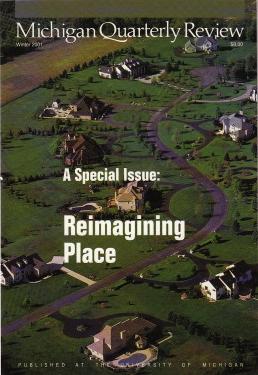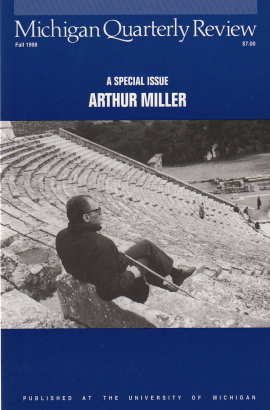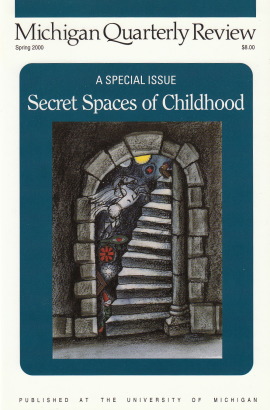A Special Issue: Reimagining Place

Edited by Robert E. Grese and John R. Knott
In this special issue of 292 pages, including a full-color portfolio of artwork, MQR sponsors an in-depth examination of how places—those we live in, those we visit, and those we dream about—affect our imaginations, and how we in turn make a home for ourselves in them, or stigmatize them as unworthy of our best values. Scholarly and personal essays focus on discrete places; fiction, poetry, and book reviews enhance the issue’s range and depth. Some of the contents:
Nonfiction: Yi-Fu Tuan in “The Desert and I: A Study in Affinity” presents a fascinating portrait of the most unlikely space for human devotion. Mary Oliver in her long poem, “On Losing a Home,” accounts for the powerful pull of residence and sanctuary in our imaginations. John R. Gillis in “Places Remote and Islanded” speaks of the compelling power of islands to inflame the human heart, and gives an autobiographical demonstration related to Gotts Island, Maine. Gary Snyder considers the impact of immigration on wilderness and rural spaces, not to mention cities. Could it be that the United States is undergoing too much of a good thing, and needs to change its policies? Sandra Alcosser in “Glyphs” presents a meditation on the experience of movement through the middle of the country, informed by memories of Lewis and Clark and a poet’s close attention to the full embodiment of the landscape. Ted McLachlan in “Horizon” makes the point that humans define place in terms of a boundary, and that what limits our perception also focuses it. This leads him to some insights on the appeal of nature photography. Catherine Badgley in “Your Real Destination” asserts that mountain climbing can bring us closer to self-discovery than almost any other enterprise; self-knowledge is the “real destination” of physical ascent.
Also included are Tom Jenz’s “Last of the Wild Horses” in which the author visits a mustang reservoir in South Dakota, a labor of love for the spirit of wild creatures, a place with a fascinating history. Julene Bair in “Night in the Mojave” contrasts the authenticity of the desert and the phoniness of Disneyland in a personal essay of great eloquence. Linda M. Hasselstrom in “Reimagining Windbreak House” tells how she established a refuge for women writers on the prairies, a soul-healing house and grounds full of companionship and interaction with the environment. Kent C. Ryden in “Big Trees, Back Yards, and the Borders of Nature” traces back to childhood our need to both occupy and transgress the borders set by nature and ourselves for our residence on earth. John Tallmadge in “Resistance to Urban Nature” wonders why we have such an animus to “invasive species” that, he claims, add diversity to urban spaces. Wouldn’t it be better to tolerate, even encourage them to settle among us and flourish? Rinda West in “Restoring Land, Community, and Soul” answers NO! in thunder to Tallmadge’s question. Rachel Kaplan in “Nature in the Eye of the Beholder” poses the questions basic to all of the essays described above: What do we mean by “nature” and why should we prefer it to what is non-nature? The Samuel T. Dana Professor of Environment and Behavior at the University of Michigan, she brings the training of a psychologist to her acute answers.
Fiction: Cathy Cruise’s short story “Other People’s Lives” which studies how a pregnant wife and her naturalist husband cope in an alternative community far from the customary attitudes and conveniences of civilization. And Paula Nangle in “Svikiro” tells how a white woman reimagines her childhood in rural Rhodesia (now Zimbabwe), and especially her awakening to the beauty and fatality of that environment.
Poetry: New poems from Sandra Alcosser, Annie Finch, Paula Friedman, John Glowney, Dolores Hayden, Elizabeth Holmes, Susan Lasher, Walt McDonald, Amy Spade, and Virgil Suarez are featured.
Reviews: Richard Francaviglia, Michael Kowalewski, and Randall Roorda survey important new work in many genres and modes that fall under the rubric, ecocriticism.
Graphics: S. MacLean contributes an introduction and a set of eight full-color aerial photographs of landscapes that reveal the impact when natural and cultural forces collide. MacLean’s book, Taking Measures Across the American Landscape (Yale University Press) established the viability of this significant new artform as a mode of social commentary.



